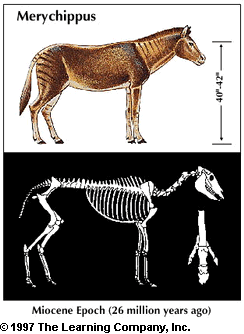
About twenty million years ago, during the Miocene period, the earth was drastically changing. Great plains were developing, forests were thinning out, mountains were forming, and swamps dried up. This brought about many changes in the horse. Since leafy food had become scarce, it had to eat the grass of the plains. The molar teeth developed high crowns and a hard covering for grinding the grass, which was covered with dust and sand. Also, their body size increased and their legs and face lengthened. The bones in the legs fused. This, along with muscle development, allowed the horse to move with forward-and-back strides, causing flexible leg rotation to be eliminated. Most importantly, the horses began to stand on their middle toe, which made them run faster, instead of walking on pads; their weight was supported by ligaments under the fetlock to the big central toe. Their side toes seldom touched the ground.

Merychippus lived during this period. These horses lived in herds. It was about twelve hands (48 inches) tall, which was the tallest equine yet. The muzzle became longer, the jaw deeper, and the eyes wider apart. The brain was much larger, making it smarter and more agile. Merychippus was the first equine to have the distinguishable head of today's horses. The foot was fully supported by ligaments, and the middle toe developed into a hoof, which did not have a pad on the bottom. In some Merychippus species, the side toes were larger, whereas in others, they had become smaller and only touched the ground when running. Its teeth were like those of Parahippus (the extra crest that was variable in Miohippus became permanent and the other teeth were beginning to form a series of tall crests with higher crowns).

By the end of the Miocene, Merychippus was one of the first speedy grazers. It gave rise to at least nineteen different species of grazers, which can be categorized into three major groups. This "burst" of evolution is often known as the "Merychippine radiation."
The first was a series of three-toed grazers known as "hipparions." These were very successful and split into four genera and at least sixteen species, including small and large grazers and browsers with large and elaborate facial fossae. The second was a group of smaller horses, known as "protohippines." These included Protohippus and Calippus. The last was a line of "true equines" where the side toes became smaller. These were eventually lost altogether as a result of the development of side ligaments that helped stabilize the middle toe during running.